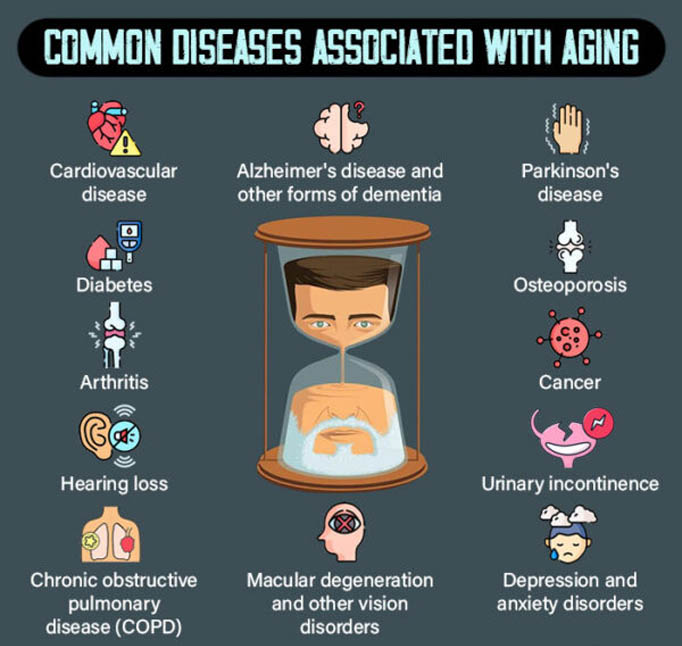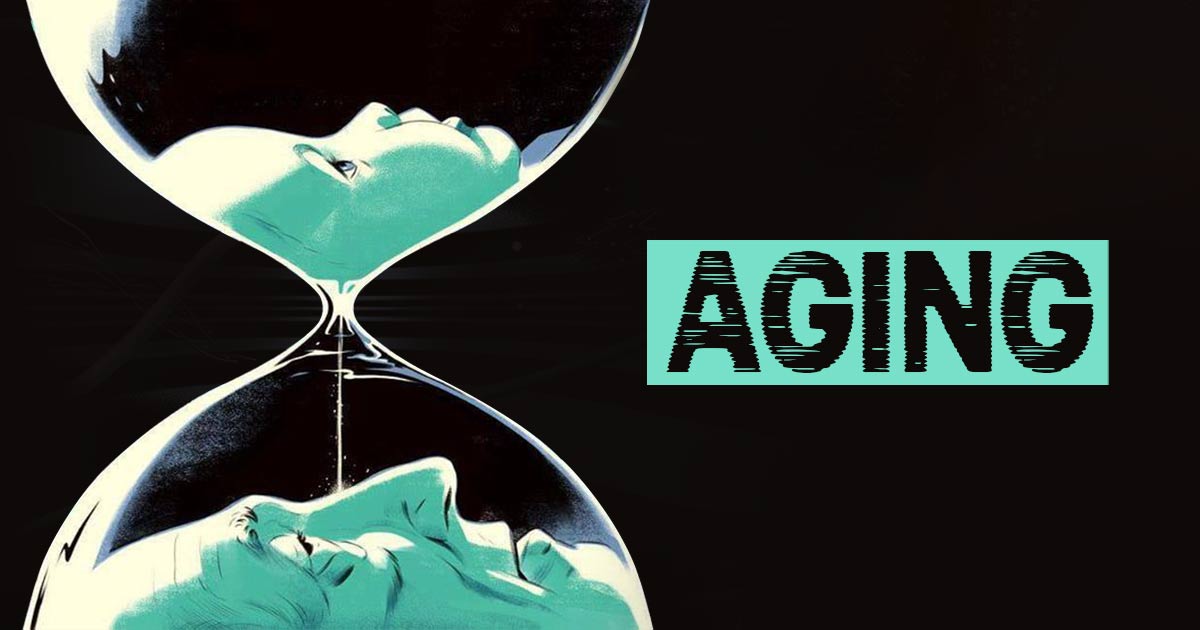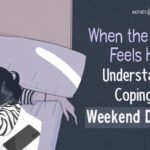Aging is an inevitable process that affects us all as we grow older, with changes occurring in biological, physiological, and behavioral aspects. These changes come with an individual’s own physical and mental health challenges, as aging makes us more vulnerable to disease and death.
What Is Aging?
Aging is a series of physical and psychological changes 1 Park, D. C., & Yeo, S. G. (2013). Aging. Korean journal of audiology, 17(2), 39–44. https://doi.org/10.7874/kja.2013.17.2.39 that collectively occur in the body and mind over the passage of time. While some aging processes are positive (such as a growth spurt in adolescence), aging is predominantly associated with old age. The aging process in the elderly leads to dysfunctions of organs, reduced mobility, and greater susceptibility to mortality.
Although the maximum human lifespan is expected to be around 115 years 2 Eisenstein, M. (2022). Does the human lifespan have a limit? Nature, 601(7893), S2–S4. https://doi.org/10.1038/d41586-022-00070-1 , some individuals have lived beyond this age. This is because aging is an individualized experience, influenced by factors, such as genetics, lifestyle, and environment.
On the other hand, some people experience premature aging due to unhealthy lifestyle choices and an innate disposition toward diseases.
Examples Of Aging
Aging involves a number of bodily changes and signs 3 Flint, B., & Tadi, P. (2021). Physiology, Aging. PubMed; StatPearls Publishing. Available from: https://www.ncbi.nlm.nih.gov/books/NBK556106/ , such as:
- Wrinkles and age spots on the skin
- Grey hair
- Decreased muscle mass and strength
- Reduced flexibility and mobility
- Memory problems and reduced attention spans
- Increased risk of chronic diseases like cardiovascular disease and cancer
- Changes in hearing and vision loss
- Decreased metabolism and energy levels
- Changes in sleep patterns and quality
- Changes in hormonal levels and function
- Increased susceptibility to infections and illnesses

Types Of Aging
Research 4 da Costa, J. P., Vitorino, R., Silva, G. M., Vogel, C., Duarte, A. C., & Rocha-Santos, T. (2016). A synopsis on aging-Theories, mechanisms and future prospects. Ageing research reviews, 29, 90–112. https://doi.org/10.1016/j.arr.2016.06.005 attributes the common types of aging to the following:
1. Chronological aging
Usually measured in years, this refers to the passage of time since an individual’s birth.
2. Biological aging
This refers to the changes in the body that occur with age, contributing to organ dysfunction. Biological aging can be of several types, including:
- Cellular aging, or a decrease in the efficiency of cellular repair
- Hormonal aging, or the natural decline in hormone production
- Accumulative damage, or the collective wear and tear occurring in our body’s organs and tissues
- Metabolic aging, or the reduction in our body’s metabolic capacity 5 Hirabayashi, T., Nakanishi, R., Tanaka, M., Nisa, B. U., Maeshige, N., Kondo, H., & Fujino, H. (2021). Reduced metabolic capacity in fast and slow skeletal muscle via oxidative stress and the energy-sensing of AMPK/SIRT1 in malnutrition. Physiological reports, 9(5), e14763. https://doi.org/10.14814/phy2.14763 (like the reduction in the body’s muscle or fat content)
3. Psychological aging
This refers to the changes in cognitive, emotional, and social functioning that occur with age. Psychological aging can include changes in memory, attention, mood, etc., and susceptibility to severe mental health conditions (like dementia).
Read More About Dementia Here
4. Social aging
This refers to the changes in an individual’s social roles, relationships, and interactions that occur with age. Social aging can involve changes in family dynamics, social support networks, and participation in community activities.
5. Cultural aging
This refers to how aging is perceived and valued in different cultures across the world. The cultural psychology of aging is often characterized by staunch agism (like the prejudice that aging comes with reduced physical attractiveness and capability)—contributing to:
- The stigmatization of aging
- Negative expectations for behavior and roles
- Reduced access to resources and services for older adults, etc.
Stages Of Aging
There is no universally agreed-upon set of stages of aging. However, for clinical purposes, studies have homogenized aging into 5 stages 6 van Beek, J. H., Kirkwood, T. B., & Bassingthwaighte, J. B. (2016). Understanding the physiology of the ageing individual: computational modelling of changes in metabolism and endurance. Interface focus, 6(2), 20150079. https://doi.org/10.1098/rsfs.2015.0079 , namely:
1. Preclinical stage
This stage begins in early adulthood and is characterized by a minimal but gradual decline in physical and cognitive functions. It can last for several decades and is marked by subtle changes in organ function, such as a decrease in lung capacity and a reduction in kidney function.
2. Clinical stage
This stage typically begins in the mid-60s and is characterized by noticeable changes in physical and cognitive functions. It is marked by an increased risk of chronic diseases, such as arthritis, hypertension, and diabetes. Changes in lifestyle, such as retirement and reduced social activity often accompany this stage.
3. Severe stage
This stage typically occurs in the 70s and 80s and is characterized by a significant debilitating decline in physical and cognitive functioning. Individuals in this stage may experience difficulty with daily activities, such as bathing, dressing, and eating. They are also at an enhanced susceptibility to severe chronic conditions, such as Alzheimer’s disease, stroke, and cancer.
Read More About Alzheimer’s Disease Here
4. Terminal stage
This stage occurs in the last months or years of life, characterized by persistent ailments and minimal mobility. Individuals in this stage may require constant care and support to perform even basic activities of daily living.
5. Post-mortem stage
This stage occurs after death and is marked by the physical and biochemical changes occurring in the body as it decomposes. While this stage is not strictly a part of the aging process, it is a natural part of the life cycle.
Aging And Health
Aging and health are closely related, as aging is a natural process that can impact physical and mental health in various ways. The aging process creates health issues 7 Plácido, A. I., Herdeiro, M. T., & Roque, F. (2022). Health and Wellbeing in Aging. International journal of environmental research and public health, 19(14), 8835. https://doi.org/10.3390/ijerph19148835 because as the body gets older, its cells and tissues undergo a natural process of wear and tear that can lead to various physical and psychological changes.
This process can affect different parts of the body, including organs, bones, muscles, and the immune system, making them more susceptible to disease and injury.
Additionally, over time, the body’s ability to repair and regenerate itself declines, which can contribute to the development of chronic conditions. Other factors that can contribute to age-related physical and mental health issues include genetics, lifestyle factors such as diet and exercise, and exposure to environmental toxins.
Aging and physical health
Aging impacts physical health 8 Kyriazis M. (2020). Aging as “Time-Related Dysfunction”: A Perspective. Frontiers in medicine, 7, 371. https://doi.org/10.3389/fmed.2020.00371 with:
- Reduced muscle mass and strength, which increases the risk of falls and injuries
- Decreased bone density, which increases the risk of fractures and osteoporosis
- Reduced bladder control, coordination, and balance
- Changes in vision and hearing, which impact daily activities and safety
- Slower metabolism, making the body susceptible to hormone fluctuations, obesity, diabetes, etc.
- Decreased immune function and increased risks of infections
- Changes in cardiovascular function, such as high blood pressure, higher risks of stroke and heart disease, etc.
- Reduced lung function and increased risk of respiratory infections
- Increased risk of chronic conditions like arthritis and different types of cancer
- Reduced ability to regulate body temperature, enhancing the risk of heat stroke and hypothermia
- Reduced fertility and sex drive
Aging and mental health
Some of the ways 9 National Research Council (US) Panel on a Research Agenda and New Data for an Aging World. (2019). The Health of Aging Populations. Nih.gov; National Academies Press (US). Available from: https://www.ncbi.nlm.nih.gov/books/NBK98373/ in which aging can impact mental health 10 Fernandes, L., & Paúl, C. (2017). Editorial: Aging and Mental Health. Frontiers in aging neuroscience, 9, 25. https://doi.org/10.3389/fnagi.2017.00025 include:
- Cognitive changes, including a decline in attention, processing speed, and motor control
- Increased risk of mental health conditions, like depression, anxiety, obsessive-compulsive disorder (OCD), hoarding symptoms, etc.
- Increased risk of memory disorders, like dementia and Alzheimer’s disease
- An obsessive preoccupation with mortality and death
- Stigmatization of agism and increased social isolation
- Lower scores of self-esteem and confidence
- Disruptive eating and sleep patterns
- Stress-related to changes in physical health, caregiving responsibilities, and financial concerns
Read More About Aging And Mental Health Here
How To Slow Aging Down
Aging is an irreversible process, but certain steps that help us prioritize our health 11 Abud, T., Kounidas, G., Martin, K. R., Werth, M., Cooper, K., & Myint, P. K. (2022). Determinants of healthy ageing: a systematic review of contemporary literature. Aging clinical and experimental research, 34(6), 1215–1223. https://doi.org/10.1007/s40520-021-02049-w and well-being can help us age more gracefully and enjoy a higher quality of life in our later years. These include:
- Healthy lifestyle choices—involving regular exercise, a balanced diet, reduced consumption of alcohol and tobacco, and stress management techniques—that can help reduce the risk of age-related diseases and improve overall well-being.
- Regular medical check-ups and early detection of health problems help to prevent or manage age-related conditions.
- Most importantly, maintaining social connections and engaging in stimulating activities can also help promote sound cognitive and mental health in later life.
Moreover, certain interventions 12 Longo, V. D., Antebi, A., Bartke, A., Barzilai, N., Brown-Borg, H. M., Caruso, C., Curiel, T. J., de Cabo, R., Franceschi, C., Gems, D., Ingram, D. K., Johnson, T. E., Kennedy, B. K., Kenyon, C., Klein, S., Kopchick, J. J., Lepperdinger, G., Madeo, F., Mirisola, M. G., Mitchell, J. R., … Fontana, L. (2015). Interventions to Slow Aging in Humans: Are We Ready?. Aging cell, 14(4), 497–510. https://doi.org/10.1111/acel.12338 have provenly slowed down or partially reversed some aspects of the aging process in laboratory animals and human subjects.
These include caloric restriction, exercise, certain drugs, and genetic manipulation. However, the safety and efficacy 13 Tosato, M., Zamboni, V., Ferrini, A., & Cesari, M. (2007). The aging process and potential interventions to extend life expectancy. Clinical interventions in aging, 2(3), 401–412. of these interventions are still being studied, as their long-term effects on health and lifespan are uncertain.
Takeaway
Old age and aging are natural processes that are accompanied by stark physical and mental changes. While aging can present challenges to an individual’s well-being, the experience of aging is unique to each individual—influenced as it is by an array of factors. However, by embracing the aging process and taking proactive steps to prioritize our health and well-being, we can enjoy a fulfilling and meaningful life as our life progresses.
At A Glance
- Aging is a natural biological process that all living organisms experience.
- It is characterized by progressive physical, cellular, and molecular changes.
- There are 5 stages of aging.
- As we age, our bodies undergo wear and tear, leading to several physical and mental health conditions.
- Genetics, lifestyle factors, and environmental factors can all play a role in the aging process and influence how we age.
- While aging cannot be stopped, taking proactive steps that prioritize health (like healthy lifestyle choices, regular medical check-ups, and social connections) promotes healthy aging.
Frequently Asked Questions (FAQs)
1. Why is aging so hard?
Aging is hard because it involves a complex set of biological processes that gradually accumulate damage and impair the body’s ability to maintain its functions. As one ages, he/she is at a higher risk of disease, disability, and death.
2. What’s the best thing about aging?
The advantages of aging lie in its association with a greater sense of wisdom, self-awareness, and emotional stability.
3. What is the purpose of aging?
The purpose of aging is a subject of debate. Some theories suggest that aging is a result of accumulated damage to cells and tissues over time, while others propose that it may be an evolutionary adaptation that favors the survival of younger generations.
4. Can aging be reversed?
There is currently no known way to reverse aging completely. However, certain interventions like caloric restriction, exercise, certain drugs, and genetic manipulation have been shown to slow down or partially reverse some aspects of the aging process in animals and humans alike.















